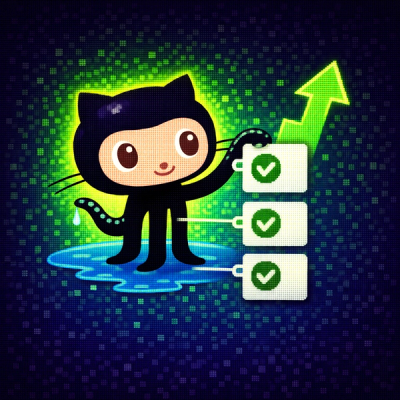
Security News
GitHub Actions Pricing Whiplash: Self-Hosted Actions Billing Change Postponed
GitHub postponed a new billing model for self-hosted Actions after developer pushback, but moved forward with hosted runner price cuts on January 1.
@capacitor/app
Advanced tools
The App API handles high level App state and events.For example, this API emits events when the app enters and leaves the foreground, handles deeplinks, opens other apps, and manages persisted plugin state.
The App API handles high level App state and events. For example, this API emits events when the app enters and leaves the foreground, handles deeplinks, opens other apps, and manages persisted plugin state.
npm install @capacitor/app
npx cap sync
For being able to open the app from a custom scheme you need to register the scheme first. You can do it by editing the Info.plist file and adding this lines.
<key>CFBundleURLTypes</key>
<array>
<dict>
<key>CFBundleURLName</key>
<string>com.getcapacitor.capacitor</string>
<key>CFBundleURLSchemes</key>
<array>
<string>mycustomscheme</string>
</array>
</dict>
</array>
For being able to open the app from a custom scheme you need to register the scheme first. You can do it by adding this lines inside the activity section of the AndroidManifest.xml.
<intent-filter>
<action android:name="android.intent.action.VIEW" />
<category android:name="android.intent.category.DEFAULT" />
<category android:name="android.intent.category.BROWSABLE" />
<data android:scheme="@string/custom_url_scheme" />
</intent-filter>
custom_url_scheme value is stored in strings.xml. When the Android platform is added, @capacitor/cli adds the app's package name as default value, but can be replaced by editing the strings.xml file.
import { App } from '@capacitor/app';
App.addListener('appStateChange', ({ isActive }) => {
console.log('App state changed. Is active?', isActive);
});
App.addListener('appUrlOpen', data => {
console.log('App opened with URL:', data);
});
App.addListener('appRestoredResult', data => {
console.log('Restored state:', data);
});
const checkAppLaunchUrl = async () => {
const { url } = await App.getLaunchUrl();
console.log('App opened with URL: ' + url);
};
| Prop | Type | Description | Default | Since |
|---|---|---|---|---|
disableBackButtonHandler | boolean | Disable the plugin's default back button handling. Only available for Android. | false | 7.1.0 |
In capacitor.config.json:
{
"plugins": {
"App": {
"disableBackButtonHandler": true
}
}
}
In capacitor.config.ts:
/// <reference types="@capacitor/app" />
import { CapacitorConfig } from '@capacitor/cli';
const config: CapacitorConfig = {
plugins: {
App: {
disableBackButtonHandler: true,
},
},
};
export default config;
exitApp()getInfo()getState()getLaunchUrl()minimizeApp()toggleBackButtonHandler(...)addListener('appStateChange', ...)addListener('pause', ...)addListener('resume', ...)addListener('appUrlOpen', ...)addListener('appRestoredResult', ...)addListener('backButton', ...)removeAllListeners()exitApp() => Promise<void>
Force exit the app. This should only be used in conjunction with the backButton handler for Android to
exit the app when navigation is complete.
Ionic handles this itself so you shouldn't need to call this if using Ionic.
Since: 1.0.0
getInfo() => Promise<AppInfo>
Return information about the app.
Returns: Promise<AppInfo>
Since: 1.0.0
getState() => Promise<AppState>
Gets the current app state.
Returns: Promise<AppState>
Since: 1.0.0
getLaunchUrl() => Promise<AppLaunchUrl | undefined>
Get the URL the app was launched with, if any.
Returns: Promise<AppLaunchUrl>
Since: 1.0.0
minimizeApp() => Promise<void>
Minimizes the application.
Only available for Android.
Since: 1.1.0
toggleBackButtonHandler(options: ToggleBackButtonHandlerOptions) => Promise<void>
Enables or disables the plugin's back button handling during runtime.
Only available for Android.
| Param | Type |
|---|---|
options | ToggleBackButtonHandlerOptions |
Since: 7.1.0
addListener(eventName: 'appStateChange', listenerFunc: StateChangeListener) => Promise<PluginListenerHandle>
Listen for changes in the app or the activity states.
On iOS it's fired when the native UIApplication.willResignActiveNotification and UIApplication.didBecomeActiveNotification events get fired. On Android it's fired when the Capacitor's Activity onResume and onStop methods gets called. On Web it's fired when the document's visibilitychange gets fired.
| Param | Type |
|---|---|
eventName | 'appStateChange' |
listenerFunc | StateChangeListener |
Returns: Promise<PluginListenerHandle>
Since: 1.0.0
addListener(eventName: 'pause', listenerFunc: () => void) => Promise<PluginListenerHandle>
Listen for when the app or the activity are paused.
On iOS it's fired when the native UIApplication.didEnterBackgroundNotification event gets fired. On Android it's fired when the Capacitor's Activity onPause method gets called. On Web it's fired when the document's visibilitychange gets fired and document.hidden is true.
| Param | Type |
|---|---|
eventName | 'pause' |
listenerFunc | () => void |
Returns: Promise<PluginListenerHandle>
Since: 4.1.0
addListener(eventName: 'resume', listenerFunc: () => void) => Promise<PluginListenerHandle>
Listen for when the app or activity are resumed.
On iOS it's fired when the native UIApplication.willEnterForegroundNotification event gets fired. On Android it's fired when the Capacitor's Activity onResume method gets called, but only after resume has fired first. On Web it's fired when the document's visibilitychange gets fired and document.hidden is false.
| Param | Type |
|---|---|
eventName | 'resume' |
listenerFunc | () => void |
Returns: Promise<PluginListenerHandle>
Since: 4.1.0
addListener(eventName: 'appUrlOpen', listenerFunc: URLOpenListener) => Promise<PluginListenerHandle>
Listen for url open events for the app. This handles both custom URL scheme links as well as URLs your app handles (Universal Links on iOS and App Links on Android)
| Param | Type |
|---|---|
eventName | 'appUrlOpen' |
listenerFunc | URLOpenListener |
Returns: Promise<PluginListenerHandle>
Since: 1.0.0
addListener(eventName: 'appRestoredResult', listenerFunc: RestoredListener) => Promise<PluginListenerHandle>
If the app was launched with previously persisted plugin call data, such as on Android when an activity returns to an app that was closed, this call will return any data the app was launched with, converted into the form of a result from a plugin call.
On Android, due to memory constraints on low-end devices, it's possible that, if your app launches a new activity, your app will be terminated by the operating system in order to reduce memory consumption.
For example, that means the Camera API, which launches a new Activity to take a photo, may not be able to return data back to your app.
To avoid this, Capacitor stores all restored activity results on launch.
You should add a listener for appRestoredResult in order to handle any
plugin call results that were delivered when your app was not running.
Once you have that result (if any), you can update the UI to restore a logical experience for the user, such as navigating or selecting the proper tab.
We recommend every Android app using plugins that rely on external Activities (for example, Camera) to have this event and process handled.
| Param | Type |
|---|---|
eventName | 'appRestoredResult' |
listenerFunc | RestoredListener |
Returns: Promise<PluginListenerHandle>
Since: 1.0.0
addListener(eventName: 'backButton', listenerFunc: BackButtonListener) => Promise<PluginListenerHandle>
Listen for the hardware back button event (Android only). Listening for this event will disable the
default back button behaviour, so you might want to call window.history.back() manually.
If you want to close the app, call App.exitApp().
| Param | Type |
|---|---|
eventName | 'backButton' |
listenerFunc | BackButtonListener |
Returns: Promise<PluginListenerHandle>
Since: 1.0.0
removeAllListeners() => Promise<void>
Remove all native listeners for this plugin
Since: 1.0.0
| Prop | Type | Description | Since |
|---|---|---|---|
name | string | The name of the app. | 1.0.0 |
id | string | The identifier of the app. On iOS it's the Bundle Identifier. On Android it's the Application ID | 1.0.0 |
build | string | The build version. On iOS it's the CFBundleVersion. On Android it's the versionCode. | 1.0.0 |
version | string | The app version. On iOS it's the CFBundleShortVersionString. On Android it's package's versionName. | 1.0.0 |
| Prop | Type | Description | Since |
|---|---|---|---|
isActive | boolean | Whether the app is active or not. | 1.0.0 |
| Prop | Type | Description | Since |
|---|---|---|---|
url | string | The url used to open the app. | 1.0.0 |
| Prop | Type | Description | Since |
|---|---|---|---|
enabled | boolean | Indicates whether to enable or disable default back button handling. | 7.1.0 |
| Prop | Type |
|---|---|
remove | () => Promise<void> |
| Prop | Type | Description | Since |
|---|---|---|---|
url | string | The URL the app was opened with. | 1.0.0 |
iosSourceApplication | any | The source application opening the app (iOS only) https://developer.apple.com/documentation/uikit/uiapplicationopenurloptionskey/1623128-sourceapplication | 1.0.0 |
iosOpenInPlace | boolean | Whether the app should open the passed document in-place or must copy it first. https://developer.apple.com/documentation/uikit/uiapplicationopenurloptionskey/1623123-openinplace | 1.0.0 |
| Prop | Type | Description | Since |
|---|---|---|---|
pluginId | string | The pluginId this result corresponds to. For example, Camera. | 1.0.0 |
methodName | string | The methodName this result corresponds to. For example, getPhoto | 1.0.0 |
data | any | The result data passed from the plugin. This would be the result you'd expect from normally calling the plugin method. For example, CameraPhoto | 1.0.0 |
success | boolean | Boolean indicating if the plugin call succeeded. | 1.0.0 |
error | { message: string; } | If the plugin call didn't succeed, it will contain the error message. | 1.0.0 |
| Prop | Type | Description | Since |
|---|---|---|---|
canGoBack | boolean | Indicates whether the browser can go back in history. False when the history stack is on the first entry. | 1.0.0 |
(state: AppState): void
(event: URLOpenListenerEvent): void
(event: RestoredListenerEvent): void
(event: BackButtonListenerEvent): void
cordova-plugin-app-event is a Cordova plugin that provides event listeners for app lifecycle events. It offers similar functionalities for handling app state changes and URL events. However, it is specific to Cordova and may not be as integrated with modern frameworks like Capacitor.
expo-app-loading is an Expo package that helps manage the app loading state. While it does not provide the full range of functionalities of @capacitor/app, it is useful for managing the app's loading state and ensuring that the app is fully loaded before rendering. It is specific to Expo and React Native.
FAQs
The App API handles high level App state and events.For example, this API emits events when the app enters and leaves the foreground, handles deeplinks, opens other apps, and manages persisted plugin state.
The npm package @capacitor/app receives a total of 253,961 weekly downloads. As such, @capacitor/app popularity was classified as popular.
We found that @capacitor/app demonstrated a healthy version release cadence and project activity because the last version was released less than a year ago. It has 18 open source maintainers collaborating on the project.
Did you know?

Socket for GitHub automatically highlights issues in each pull request and monitors the health of all your open source dependencies. Discover the contents of your packages and block harmful activity before you install or update your dependencies.

Security News
GitHub postponed a new billing model for self-hosted Actions after developer pushback, but moved forward with hosted runner price cuts on January 1.

Research
Destructive malware is rising across open source registries, using delays and kill switches to wipe code, break builds, and disrupt CI/CD.

Security News
Socket CTO Ahmad Nassri shares practical AI coding techniques, tools, and team workflows, plus what still feels noisy and why shipping remains human-led.